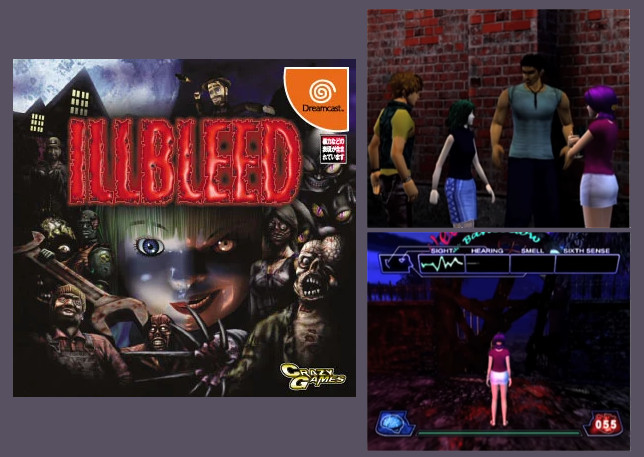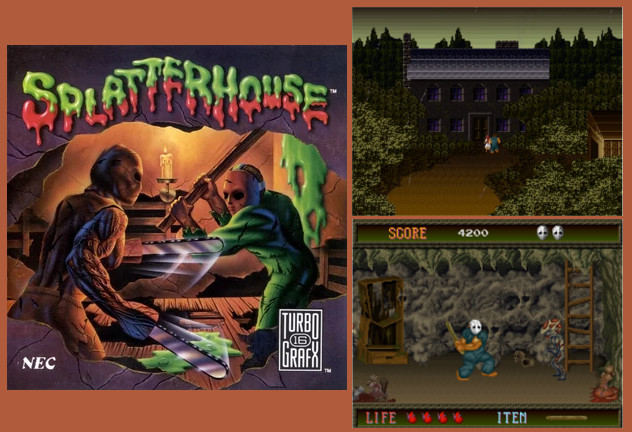For October 2020, the retro games of the month shall be:
- Illbleed – 2001 – survival horror
- Splatterhouse – 1988 – beat-em-up

Illbleed is a bizarre survival horror game for the Sega Dreamcast, developed by the appropriately-named Crazy Games studio (their only other console game being Blue Stinger… another strange action/horror-ish Dreamcast exclusive). Founded by Shinya Nishigaki, Crazy Games was an off-shoot of Climax Entertainment, responsible for games like Landstalker (Genesis), Dark Savior (Saturn), and Time Stalkers (Dreamcast). Unfortunately for Illbleed, it was released shortly after Sega announced the discontinuation of the Dreamcast, and most gamers were getting their survival horror fix from the Playstation 2 (such as earlier “retro game of the month” game Onimusha, released a couple months prior).
But the thing is, we probably shouldn’t just be calling Illbleed a survival horror game. Its tone is intentionally a blend of weird, surreal, and downright corny sorts of horrors – which can perhaps come off as creepy at times, but in a different way from your more traditionally monstrous Resident Evil or more psychological Silent Hill. And because Illbleed is so strange and unique within its genre, it has become something of a cult classic over the years, and its used copies now sell for a good $200 these days. (I will be using Redream on my computer.) The game is made up of six different stages, each riffing a different type of horror movie. Apparently Illbleed shakes things up in each “world,” making the game a sort of wacky horror anthology.
It’s not just the tone and presentation that is special in Illbleed though – the gameplay is also something unexpected. The story places you in a spooky death trap-filled amusement park, in search of your friends who visited it prior and haven’t returned. In order to avoid said death traps, you have to use special goggles to “mark” spots of potential danger… a bit like Minesweeper. You use four senses to figure out where traps might be: sight, hearing, smell, and “sixth sense.” These senses can alert you to items and enemies as well. Also important for this game, you will have to watch more than just your health bar – you also have blood, heart rate, and adrenaline. Suffice to say, you’ll need to be cautious yet thorough in your exploration, and put your observation skills to good use.
Illbleed was only released for the Dreamcast, and Howlongtobeat dot com says to give it 9 and a half hours to play through. An updated port to the original Xbox, as well as hopes for a sequel game, unfortunately never materialized when Crazy Games shut down and creator Shinya Nishigaki passed away of a heart attack a couple years later. I think it will be interesting to take a look at how a title as obscure as Illbleed can still be considered a precursor to horror game trends in the years that followed though, from the campiness of titles like Obscure, to the nonlinear “routes” regarding who lives and who dies in hits like Until Dawn. At the very least, Kazutaka Kodaka has said Illbleed was a direct influence for the story of the Danganronpa franchise (a personal favorite of mine).

Splatterhouse will be our “arcadier” game for October, and is a fitting one for being one of the earliest horror-themed game franchises that is still remembered to this day. The first Splatterhouse game was released in arcades by Namco in 1988, and is a beat-em-up heavily influenced by slasher flicks of that decade. A Turbografx-16 (PC Engine in Japan) port was released in 1990, and had a delightful parental advisory warning on the cover:
“The horrifying theme of this game may be inappropriate for young children… and cowards.”
Namco was one of the top contributors to arcade games in the 80s. Pac-Man, Galaga, Dig Dug, Pole Position, Mappy… Lots of classic, fun, and family-friendly games. But then came Splatterhouse, from seemingly out of nowhere. It certainly wasn’t the first beat-em-up, but unlike, say, Double Dragon – Splatterhouse was filled to the brim (or perhaps overflowing with) gore. Lots and lots of ridiculous pixelated monster gore. It’s over-the-top enough to come off as silly, but still… Ghosts 'n Goblins this ain’t.
Interestingly though, despite what I’d presume were Namco’s intentions of causing a grand rumpus and getting truckloads of quarters in the process (bad publicity = free advertisement, you know), Splatterhouse didn’t cause all that much of a stir. It somehow went largely unnoticed in arcades, but became a bit more of a cult classic series thanks to its two just-as-bloody sequels on the Sega Genesis. For whatever reason, violence and mature content in video games wouldn’t become a really big concern until the likes of Mortal Kombat and Night Trap, leading to the ESRB being formed in 1994.
Probably the easiest way to play Splatterhouse now is via the Namco Museum collection available for the Switch. There were also some phone ports made back in 2010, coinciding with the release of a 3D reboot game of the same name for Playstation 3 and Xbox 360 (though that entry seems to have been panned by many critics). The Turbografx-16 version is also available to play on the Wii’s Virtual Console, and on the Turbografx-16 Mini (or PC Engine Mini).
Please feel free to share your thoughts on either (or both) of these games as you play them over the course of October. If you finish, you can give a mini-review if you’d like. Let us know if you think these games stand the test of time!